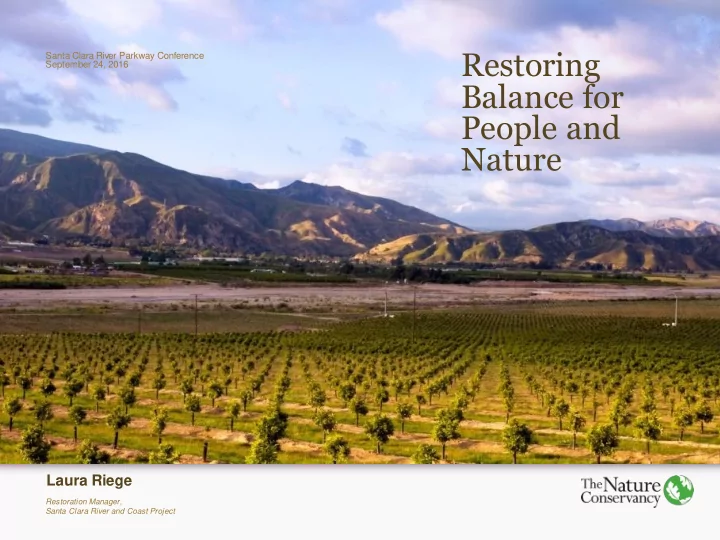

Restoring Santa Clara River Parkway Conference September 24, 2016 Balance for People and Nature Laura Riege Restoration Manager, Santa Clara River and Coast Project
TNC’s Mission OUR MISSION Conserve the lands and waters on which all life depends.
Based in Science 1915: Ecological Society of America founded to promote the science of ecology disagreement about whether or not to take a political or activist stance on ecological preservation 1946: Ecologist’s Union split off to focus on preserving nature by protecting ecological communities 1951: Ecologist’s Union became The Nature Conservancy
Conservancy Facts Non-profit organization Protected more than 119 million acres of land and 5,000 river miles worldwide Operate in more than 100 marine conservation projects Own and manage the largest network of private preserves in the U.S. Chapters in all 50 states and more than 30 countries Over 3,500 staff, including over 400 scientists
Santa Clara River
Regional Conservation Value River still in predominantly natural state Home to many rare natural communities and 32 threatened, endangered and protected species 16 million people live within an hour’s drive of the project Some of the most important wetlands in Southern California
Richness of Wildlife Coast Horned Lizard Least Bell’s Vireo Southwestern Willow Flycatcher Kylie Fischer Utah Dept. Natural Resources Mountain Lion Tidewater Goby California Red-legged Frog Arroyo Toad Pond Turtle Southern California Steelhead Unarmored Threespine Stickleback Black Bear Christopher Mosser, UC Davis
Vegetation and Rare Plants Mapping
Rare Plants Slender-horned Spineflower Ventura Marsh Milkvetch Lyon’s Pentachaeta James Bailey California Orcutt Grass Nevin’s Barberry San Fernando Valley Spineflower Jasmine J. Watts
Threats to the River Habitat Loss and Destruction from: Aggregate mining Channelization/levees Erosion/channel incision Conversion from agriculture to urban land uses Development in the floodplain Invasive non-native vegetation Poor water quality In 2005, American Rivers designated the Santa Clara River as one of the most threatened rivers in the nation.
Invasive Plants: Arundo donax (giant reed)
Invasive Plants: Arundo /giant reed
Invasive Plants: Arundo /giant reed
Arundo Facts Found throughout southern California California Invasive Plant Council Native of eastern Asia ranked the Santa Clara River Brought here as an ornamental plant, watershed as #2 of 24 watersheds for erosion control, and for the making it a high priority for treatment. production of reeds for musical instruments Uses 6-12 times more water than native vegetation Reduces stream shading, making rivers too warm for native fish Crowds out native plants, making it difficult for birds and other wildlife to make nests or find cover Removing Arundo provides millions of liters of water supply benefit annually
Other Invasive Plants Milk thistle surrounded by rip gut brome Tree tobacco Short pod mustard Salt cedar (tamarisk) Castor bean Salt cedar (tamarisk) in bloom
Santa Clara River & Coast Project Acton Ojai Santa Clarita Fillmore Newhall Santa Paula Ventura Oxnard Port Hueneme Pacific Palisades
Project Objectives Multi-benefit Conservation Program Habitat conservation Over 3,600 acres of river and coastal wetlands acquired Zoning policy achievements (Conservation Subdivision) Conservation and restoration by habitat nodes Wildlife corridors Non-structural flood protection Floodplain Easement Program Piloting green infrastructure program Land Management Promote agriculture as valued land use Leasing over 500 acres Climate Change Adaptation Coastal Resilience Ventura Natural Infrastructure
Habitat Restoration
Hanson Restoration
Banman Restoration
Restoration Focus Implement resilient, large-scale restoration that will withstand flood and fire Develop methodologies that are cost effective and replicable throughout the river and coast Share methods and lessons learned Work cooperatively with partners and farmers for natural floodplain management Plan for long-term coastal resilience and sea level rise
Scientific Studies Griffith Wildlife Biology Griffith Wildlife Biology What are the factors that will lead to the delisting of the endangered least Bell’s vireo?
Migration Monitoring
How to visit? Monthly Naturalist-led Hikes Free!! Open to the public Hiking difficulty is usually easy Under 18 accompanied by a parent or guardian
Useful Websites The Nature Conservancy – general info, national and international projects, membership www.nature.org The Santa Clara River & Coast Project description and nature hike schedule www.nature.org/ourinitiatives/regions/northamerica/unitedstates/california/plac esweprotect/la-ventura.xml Santa Clara River Parkway project description and reports www.santaclarariverparkway.org/ Coastal Resilience Ventura http://coastalresilience.org/ http://maps.coastalresilience.org/network/
Laura Riege, Restoration Manager LRiege@tnc.org 532 E. Main St., Suite 200 Ventura, CA 93001 (805) 290-4776 Thank you!
Recommend
More recommend